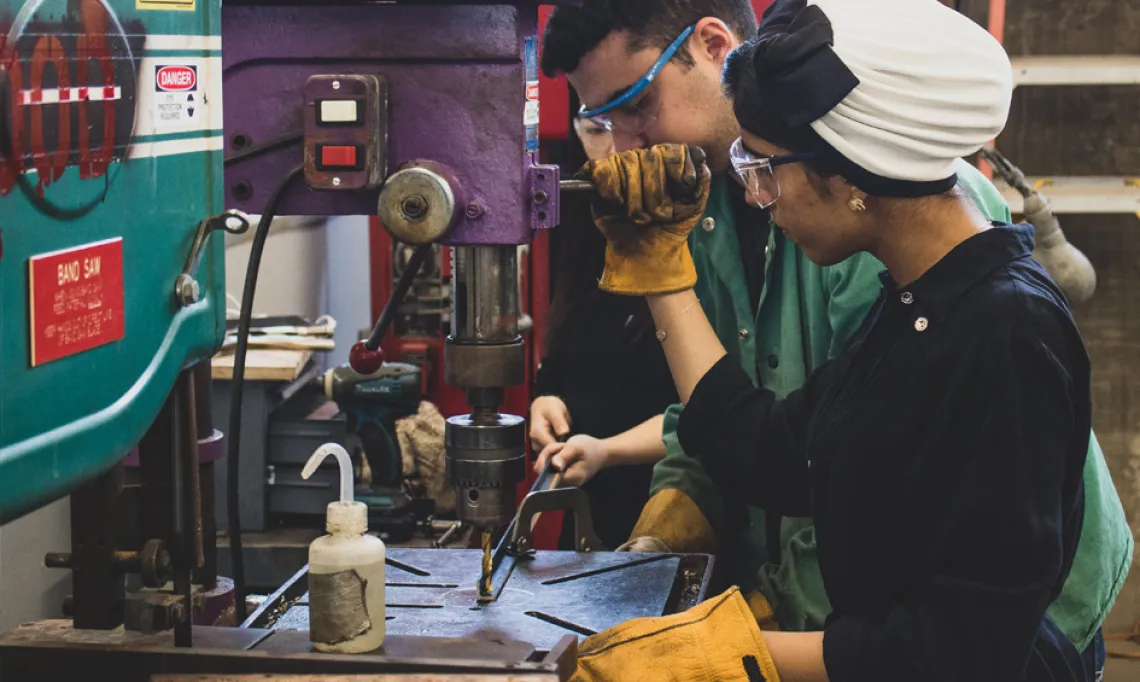
Location: A107A
The machining lab has a 14” LeBlond lathe, Bridgeport Knee Mill, The vacuum forming tool is also located here and the wash out bath for the Dimension 3D prints.
Safety and Access
All students using the machining tools must first complete the machining class. Currently the class is offered at the AME school lab. Wear appropriate clothing, roll up loose sleeves, remove jewelry, and tie back long hair. All of these can get caught in the spinning tools. Safety glasses must be worn, prescription glasses do not count. Only wear sturdy closed toe shoes while in the lab. No Slippers, No flip flops, No open toe shoes. No work is possible inside the labs after midnight, a silent alarm will be activated and you will lose your lab access. Always disconnect power and lock off the tool when making repairs. Any tool that is out of order should be reported to monitor. All injuries should be reported to the monitor.
- Safety is the responsibility of everyone in the lab.
- Proper eye protection should be worn at all times.
- Do not attempt to operate any machine before understanding how it works and how to stop it quickly is something unexpected happens.
- Make sure all guards and safety devices are in place.
- Check to be sure that the work-piece and cutting tool are properly secured before operating the machine.
- Use a proper fitting wrench for each job.
- Pulling a wrench is much safer then pushing it.
- Never start a machine until you are certain that the work-piece will clear the cutting tool and machine parts.
- Keep hand away from moving parts.
- Never measure, clean, or make adjustments unless the machine has come to a complete stop.
- Do not use rags.
- Only one person should operate a machine at any one time.
- Every injury should be treated immediately.
- Always remove sharp burrs from work-pieces with a file before handling.
- Always use a brush or vacuum to remove any chips; never use a cloth or your hand.
- Never leave head key in the lathe head.
- Always clean machine after use and put tools away.
- Never use compressed air to blow chips away from a machine.
- Always disconnect power and lock off the tool when making repairs.
- Any tool that is out of order should be reported to monitor.
Vacuum Former
The Formech Vacuum Former- Forming Area dimensions- 19"x17" with a 10" draw. Cut your sheet size to at least 20" x 18". The vacuum former can be used to thermoform thin sheets of plastic up to ¼" (ABS, PETG, Acrylic etc.) over a form (the mold). The sheets are heated up until they are soft. Next, the soft sheet is moved over a perforated plate onto which the mold is fixed. The mold then is raised into the plastic and vacuum draws the sheet tight around the mold. Once the sheet cools the vacuum is turned off, the mold is lowered and the sheet can be removed from the machine. Bear in mind that molds cannot contain any undercuts! Also, slightly tapering the mold (draft 3-5%) to facilitate the removal is recommended. Check tutorial for more info.
This machine is located in the rear area of the Machining lab. It can only be used during regular lab hours. You must be checked out with a monitor before using on your own. Vacuum forming, is a simplified version of thermoforming, whereby a sheet of plastic is heated to a forming temperature, stretched onto or into a single-surface mold, and held against the mold by applying vacuum between the mold surface and the sheet. The vacuum forming process can be used to make most product packaging, speaker casings and even car dashboards. Normally, draft angles must be present in the design on the mold (a recommended minimum of 3°), otherwise release of the formed plastic and the mold is very difficult.
Relatively deep parts can be formed if the form-able sheet is mechanically stretched (buck) prior to bringing it in contact with the mold surface and before vacuum is applied. Suitable materials for use in vacuum forming are conventionally thermoplastics, the most common and easiest being High Impact Polystyrene Sheeting (HIPS).
